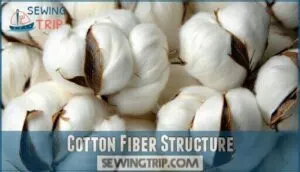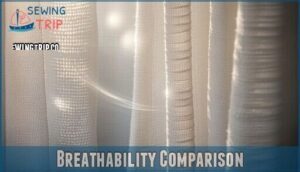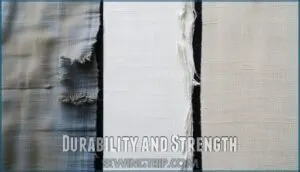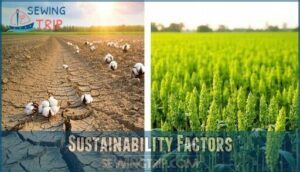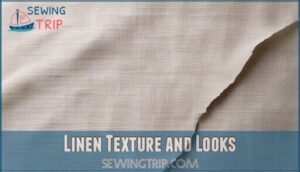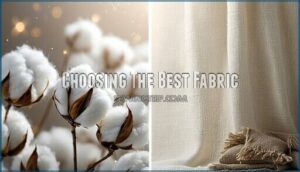This site is supported by our readers. We may earn a commission, at no cost to you, if you purchase through links.
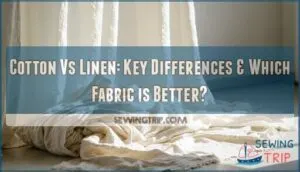 The cotton vs linen difference comes down to feel and function.
The cotton vs linen difference comes down to feel and function.
Cotton feels soft and smooth like your favorite worn-in t-shirt, while linen has a crisp, slightly rough texture that screams "effortless elegance."
Linen wins the breathability game—it’s like natural air conditioning for your skin, making it perfect for hot summer days.
Cotton’s more versatile and easier to care for, but linen gets softer and more beautiful with every wash.
Cotton comes from fluffy seed pods, while linen comes from flax plant fibers.
Both have their sweet spots, and choosing between them really depends on whether you prioritize comfort or that breezy, lived-in luxury vibe that makes people wonder where you got your style sense.
Table Of Contents
Key Takeaways
- Texture tells the story: You’ll feel cotton’s smooth, soft comfort immediately, while linen starts crisp and rough but transforms into luxurious softness with each wash.
- Linen wins the breathability battle: You’ll stay cooler in linen since it’s like natural air conditioning – it wicks moisture faster and allows superior airflow compared to cotton’s tendency to trap heat.
- Durability vs. budget trade-off: You’ll pay more upfront for linen, but it lasts decades and gets stronger over time, while cotton’s cheaper but needs replacing every 3-5 years.
- Care requirements differ dramatically: You’ll find cotton easy to maintain with regular washing and drying, but linen demands gentle handling, air drying, and careful storage to preserve its quality.
Cotton Vs Linen Origin
When you look at cotton and linen, you’re really comparing two fabrics with roots in different plants and ancient cultures.
Cotton comes from the fluffy seeds of the cotton plant, while linen is made from the sturdy stalks of the flax plant, each bringing its own story and strengths to your closet.
Cotton Plant Source
Understanding cotton begins with knowing its source—the cotton plant’s fluffy white bolls.
You’ll find cotton varieties like Egyptian and Pima thriving in warm growing regions across the United States, India, and China.
Modern harvesting methods use machines to collect cotton fibers from these bolls efficiently.
| Cotton Aspect | Key Details | Impact on You |
|---|---|---|
| Growing Regions | Warm climates: US, India, China | Affects fabric availability and cost |
| Cotton Varieties | Egyptian, Pima, Upland cotton | Determines softness and quality |
| Harvesting Methods | Machine-picked from cotton bolls | Enables large production scale |
| Fiber Properties | Short, soft, fluffy cotton fibers | Creates comfortable, versatile fabrics |
| Production Scale | Massive global cotton plant cultivation | Keeps cotton affordable worldwide |
Linen Plant Source
While cotton grows from fluffy seed pods, linen comes from the flax plant’s sturdy stalks.
European climate suits flax cultivation perfectly, where farmers use traditional farming practices. Fiber extraction requires linen retting – soaking harvested flax to break down plant material. This farming method produces strong flax fibers through careful processing steps.
Hemp, in contrast, has seen a resurgence due to its sustainable growing practices.
| Aspect | Flax Plant Details | Growing Requirements |
|---|---|---|
| Climate | Thrives in cool, moist conditions | Moderate temperatures, consistent rainfall |
| Harvesting | Pulled with roots intact | Manual labor traditionally preferred |
| Processing | Retting breaks down plant stems | Soaking separates usable fibers |
| Regions | Northern Europe, Belgium, France | Well-drained soil, temperate zones |
| Historical uses | Ancient Egyptian burial wraps | European textiles for centuries |
History of Cotton and Linen
Both fabrics boast Ancient Origins spanning thousands of years.
The cotton plant first flourished in India around 3000 BCE, while flax cultivation began in ancient Egypt.
These fibers shaped civilizations through Trade Routes connecting continents.
Global Cultivation expanded as merchants recognized their Historical Significance in textile production.
| Aspect | Cotton | Linen |
|---|---|---|
| Ancient Origins | India, 3000 BCE | Egypt, 5000 BCE |
| Early Civilizations | Indus Valley traders | Egyptian pharaohs |
| Fiber Evolution | Selective breeding for softness | Wild flax domestication |
| Trade Routes Impact | Silk Road expansion | Mediterranean commerce |
Fabric Characteristics
You’ll notice significant differences between cotton and linen fibers that affect how each fabric feels and performs.
Cotton fibers are shorter and softer with a smooth texture, while linen fibers are longer and stronger with a naturally rough, slubby appearance that softens beautifully over time.
Cotton Fiber Structure
Your cotton fabric starts with short, fluffy fibers that measure just half to two inches long.
These cotton fibers have a unique twisted ribbon structure that creates their natural softness and flexibility.
The fiber fineness varies by cotton type, with premium varieties like Pima offering finer, more uniform fibers.
Cotton fiber strength depends on fiber maturity and growing conditions, while the fiber composition remains pure cellulose throughout the cotton plant’s seedpod.
Linen Fiber Structure
Unlike cotton’s fluffy seedpod origins, linen fabric emerges from the flax plant’s strong stalks.
These flax fibers showcase remarkable fiber length—up to 20 inches compared to cotton’s half-inch strands.
Under microscopic appearance examination, linen’s cell structure reveals thick walls and hollow centers, creating superior fiber strength.
The chemical composition includes natural lignin and pectin, giving linen properties their characteristic durability and breathability that outlasts most fabrics.
Texture and Feel Comparison
When you first touch these fabrics, you’ll notice distinct differences in texture and softness. Cotton offers smooth comfort right away, while linen starts crisp but transforms beautifully over time.
Here’s how these fabrics compare in feel:
- Initial Crispness – Linen feels stiff at first, cotton feels immediately soft
- Softness Over Time – Both improve with washing, linen dramatically transforms
- Skin Sensitivity – Cotton’s gentler for sensitive skin initially
- Drape Comparison – Cotton hugs your body, linen stands away naturally
- Cling Factor – Linen texture prevents clinging, cotton may stick in humidity
To maintain fabric quality, consider gentle detergent selection.
Breathability Comparison
When you’re picking fabric for hot weather, you want something that lets air move and keeps sweat away.
Let’s see how cotton and linen stack up for breathability and staying cool.
Linen Breathability
When you touch linen fabric, you’ll notice its cool, crisp feel. That’s thanks to its hollow Fiber Structure and loose Weave Density, which boost Airflow Dynamics.
Linen benefits shine in hot weather—moisture absorption is quick, so you stay dry. If you want comfort factors and exceptional breathability, linen absorbency can’t be beat.
| Feature | Linen Fabric | Benefit |
|---|---|---|
| Fiber Structure | Hollow | Airflow Dynamics |
| Weave Density | Loose | Breathability |
| Absorbency | High | Moisture Absorption |
| Climate Suit. | Hot, Humid | Comfort Factors |
Cotton Breathability
Cotton fabric offers solid breathability through its plant-based fibers, though weave impact and fiber density affect airflow differently than linen fabric.
Cotton properties include natural air circulation, making it suitable for various activity levels and providing reliable clothing comfort across different climates.
| Cotton Feature | Breathability Rating | Best Use |
|---|---|---|
| Percale weave | High airflow | Hot weather clothing |
| Jersey knit | Moderate circulation | Everyday comfort wear |
| Flannel weave | Lower breathability | Cooler climate suitability |
| Sateen finish | Reduced airflow | Formal occasions |
| Canvas weight | Minimal circulation | Heavy-duty applications |
Cotton benefits include consistent performance across seasons, though climate suitability varies by weave type and weight.
Moisture Management
In the context of moisture management, think of linen as a quick-drying towel and cotton as a sponge that hangs on to water.
Linen’s moisture-wicking powers shine in humid spots, while cotton’s absorbency can lead to a clingy feel.
For activewear, fabrics like polyester are often used for their sweat-wicking capabilities.
Here’s a quick breakdown:
| Feature | Linen | Cotton |
|---|---|---|
| Absorption rates | Moderate | High |
| Drying speed | Fast | Slow |
| Humidity comfort | Excellent | Good |
| Cling factor | Low | High |
| Ideal climates | Hot, humid | Dry, warm |
Durability and Strength
You’ll want to know which fabric will last longer before you need to replace it.
Linen wins this battle hands down, with fibers that are roughly 30% stronger than cotton and can last for decades with proper care.
Linen Longevity
Linen durability stands out like a trusty friend who’s always there when you need them.
This longlasting fabric gets stronger with age, thanks to its robust fiber structure.
Here’s what makes linen so durable:
- Fiber lifespan extends decades with proper care
- Weave impact creates resistance against tearing and fraying
- Washing effects actually strengthen the fabric over time
- Usage patterns show linen maintains shape without sagging
The fabric durability comes from flax fibers being naturally stronger than most materials, making linen a smart investment for your wardrobe.
Cotton Longevity
While linen gets stronger with age, cotton’s lifespan tells a different story.
Your cotton clothes typically last 3-5 years with regular use.
The cotton durability depends heavily on weave impact and usage frequency.
Frequent washing effects cause fiber degradation, making cotton break down faster than its flax cousin.
Still, proper care extends cotton’s longlasting qualities substantially.
| Factor | Impact on Cotton Lifespan | Typical Timeframe |
|---|---|---|
| Daily wear items | High fiber degradation | 1-3 years |
| Casual use pieces | Moderate wear patterns | 3-5 years |
| Gentle care routine | Extended fabric durability | 5-8 years |
| Heavy washing cycles | Accelerated breakdown | 6 months-2 years |
| Quality cotton weave | Better longevity | 4-6 years |
The table highlights the impact on cotton lifespan based on various factors, including daily wear and gentle care routine.
Understanding these factors can help extend the life of your cotton clothes, making them last longer.
Fiber Strength Comparison
When you compare fabric strength head-to-head, linen’s tensile strength outperforms cotton by roughly 30%.
Linen’s strong fibers show superior abrasion resistance and remarkable wet strength – actually getting stronger when damp.
Cotton durability relies more on fiber elasticity, making it stretchy but less resilient. The weave impact matters too, but linen fabric consistently beats cotton in raw strength tests.
Sustainability Factors
When choosing between cotton and linen, you’ll want to take into account their environmental footprint since sustainability matters more than ever.
Cotton typically requires substantially more water and pesticides during cultivation, while flax plants used for linen need fewer resources and chemicals to thrive, which affects their overall environmental footprint.
Cotton Environmental Impact
Cotton’s environmental impact hits hard when you look at the numbers. You’re dealing with a crop that guzzles 7,000-10,000 liters of water per kilogram and devours pesticides like there’s no tomorrow.
Conventional cotton farming relies heavily on chemical usage, with nitrogen fertilizer alone creating 66% of cotton’s carbon footprint. Pesticide use in cotton production contributes substantially to soil degradation and water pollution.
While sustainable cotton and GMO cotton options exist, traditional cotton sustainability remains questionable due to massive water consumption and environmental impact across the supply chain. The Aral Sea’s shrinking volume highlights cotton irrigation’s impact, showing the significant effect of cotton irrigation.
Linen Environmental Impact
Regarding environmental impact, sustainable linen stands out as nature’s gift to eco-conscious consumers.
Flax cultivation requires minimal resources while the retting process can be chemical-free. Ideal flax zones require no irrigation, fertilizers, or pesticides.
Here’s why linen sustainability matters:
- Biodegradability guarantees complete decomposition within years
- Chemical usage stays minimal during production
- Carbon capture occurs naturally during growth
- Zero irrigation needed for ideal flax cultivation
Water and Pesticide Usage
In the realm of fabric, irrigation demands and pesticide runoff can’t be ignored.
Linen generally takes the lead, cutting water usage by nearly 70% and dodging the heavy pesticide use found in cotton fields.
Organic alternatives and sustainable farming keep water pollution down, making linen a wise pick if you value water conservation and cleaner agricultural practices.
Cost and Care Differences
When you’re choosing between cotton and linen, your wallet and washing machine will notice the difference right away.
Linen costs substantially more upfront but requires gentler care, while cotton offers budget-friendly comfort with easier maintenance routines, making it a choice that affects your wallet.
Linen Care Instructions
Linen’s delicate nature requires gentle handling to preserve its natural beauty and longevity.
Unlike cotton, this premium fabric demands specific washing, drying, and storage techniques to maintain its strength and appearance over time.
One key consideration is that linen’s looser weave contributes to breathability and hypoallergenic properties.
Essential linen clothing care steps:
- Washing Linen – Use cold water on gentle cycle with mild detergent to prevent fiber damage
- Drying Linen – Air dry flat or hang immediately to avoid permanent creases and shrinkage
- Ironing Linen – Iron while slightly damp using medium heat for smooth, professional results
- Storing Linen – Fold loosely or hang properly to prevent deep wrinkles and fabric stress
Cotton Care Instructions
You’ll find cotton fabric much easier to handle than linen.
Machine wash your cotton clothing in warm water up to 104°F, though hot washing temperatures work for whites. Cotton handles regular detergent well and responds to standard stain removal techniques.
For drying methods, tumble dry on medium heat or air dry. When ironing cotton, use medium to high heat settings.
Proper care can be achieved through specific wash temperatures. Store cotton items in breathable fabric care spaces to prevent moisture buildup, using proper care and breathable fabric to maintain the quality of your cotton clothing and prevent moisture buildup.
Price Comparison
When you’re weighing cotton vs linen prices, your wallet will feel the difference immediately.
Cotton affordability makes it the budget-friendly choice, while linen price reflects its labor-intensive production costs and premium positioning in the market.
- Cotton price: Ranges from $3-13 per yard, making it accessible for most budgets
- Linen affordability: Starts at $20-50 per yard due to complex flax processing requirements
- Production costs: Cotton’s machine harvesting keeps expenses low compared to linen’s manual methods
- Long-term value: Linen’s decades-long durability offsets higher upfront investment versus cotton’s 3-5 year lifespan
Texture and Appearance
When you run your fingers across these two fabrics, you’ll notice linen feels crisp and slightly rough with natural bumps called slubs that give it character.
Cotton offers a smooth, soft touch right from the start, making it instantly comfortable against your skin.
Linen Texture and Looks
When you touch linen fabric, you’ll notice its distinctive crisp texture right away.
The natural slubs create an uneven, slightly rough feel that gives linen its signature rustic aesthetic. This unique look comes from the flax plant’s inherent irregularities, which show through as charming imperfections.
Linen’s natural sheen adds subtle elegance, though the wrinkle factor means it creases easily during wear.
Cotton Texture and Looks
Unlike linen fabric, cotton texture offers immediate smoothness that feels gentle against your skin from day one.
You’ll notice cotton fabric’s consistent weave creates a uniform surface without natural slubs.
Here’s what makes cotton texture distinctive:
- Fabric smoothness – Cotton fibers create an even, soft surface that doesn’t require breaking in
- Weave variations – From tight percale to brushed flannel, cotton adapts to different textures
- Color retention – Cotton holds dyes well, maintaining vibrant colors through washing
Cotton’s crease resistance and drape quality make it versatile for everyday wear.
Rustic Charm Vs Smooth Comfort
Linen’s rustic charm comes from its natural slubs and casual drape, while cotton offers smooth comfort with uniform texture.
Your initial feel matters: cotton feels soft immediately, but linen’s long-term softness develops beautifully over time.
For skin sensitivity, cotton wins upfront.
However, linen’s aesthetic versatility shines in relaxed settings, creating that effortless, lived-in look that’s impossible to fake, with a unique rustic charm and natural beauty.
Choosing The Best Fabric
When you’re choosing between cotton and linen, you’ll want to think about how each fabric fits your needs for comfort, durability, and care.
Picking the right one can make a big difference, whether you’re looking for a cool shirt or sheets that help you sleep better at night, which is crucial for overall durability.
Linen Vs Cotton for Clothing
When choosing linen fabric versus cotton fabric for clothing, consider your specific needs.
Linen clothing excels in hot, humid weather thanks to superior breathability and moisture-wicking properties. Cotton clothing offers versatility across seasons and activities, with better skin sensitivity accommodation.
You can find linen summer clothes for ideal comfort in warm weather.
- Seasonal suitability: Linen works best in summer heat, while cotton adapts to multiple seasons
- Clothing comfort: Cotton feels softer initially; linen improves with each wash
- Activity appropriateness: Choose linen for casual occasions, cotton for formal or active wear
- Style versatility: Cotton works for any look; linen suits relaxed, elegant styles
- Fabric comparison: Linen breathes better but wrinkles more; cotton offers consistent comfort
Linen Vs Cotton for Bedding
Your bedroom’s atmosphere dramatically affects Sleep Quality, making the bedding choice vital.
Linen bed sheets excel in breathability and temperature regulation, perfect for hot sleepers and Seasonal Use during summer months. Cotton bedding offers softer comfort initially, ideal for those with Skin Sensitivity.
Many seek out high quality options for superior sleep. Cotton bedding offers softer comfort initially, ideal for those with Skin Sensitivity.
| Feature | Linen Bedding | Cotton Bedding |
|---|---|---|
| Temperature Control | Superior cooling, moisture-wicking | Moderate breathability, warmer feel |
| Durability | Lasts decades, strengthens over time | 2-5 years typical lifespan |
| Initial Feel | Crisp, softens with washing | Soft and smooth immediately |
| Bedding Aesthetics | Relaxed, wrinkled charm | Crisp, polished appearance |
| Budget Considerations | Higher upfront cost, long-term value | Lower initial price, frequent replacement |
Factors to Consider for Fabric Choice
When choosing between cotton and linen, you’ll want to weigh several key factors.
Your climate considerations matter most—linen’s superior breathability suits hot, humid areas while cotton works well in varied conditions.
Consider your intended use and personal preference for texture.
- Climate considerations: Linen excels in heat; cotton adapts to most climates
- Budget constraints: Cotton costs less upfront; linen offers long-term value
- Durability needs: Linen lasts decades; cotton requires more frequent replacement
- Ethical sourcing: Linen uses less water; cotton needs more pesticides
Frequently Asked Questions (FAQs)
What is the difference between cotton & linen?
Picture running your fingers across two fabrics: cotton feels smooth and soft immediately, while linen starts crisp but becomes luxurious with time.
Cotton’s affordable and comfortable, but linen’s stronger, more breathable, and lasts decades despite costing more.
How does linen compare to cotton for bedding?
You’ll sleep cooler with linen bedding since it wicks moisture better and allows superior airflow.
Cotton sheets may trap heat overnight, while linen’s loose weave keeps you comfortable in humid conditions, making linen a better choice for a cooler sleep.
Why is linen more expensive than cotton?
Linen costs more because it takes more work to make.
You’ve got to pull up flax plants by hand, then go through several tricky steps.
Cotton’s made faster by machines, so it’s usually cheaper.
Are cotton & linen eco-friendly?
Both fabrics have eco-friendly qualities, but linen wins the green game.
You’ll find that flax needs less water and fewer pesticides than cotton, making linen the more sustainable choice for environmentally conscious shoppers.
Which is better cotton or linen?
Neither is definitively "better" – it depends on your needs. You’ll love linen’s breathability and durability for hot weather, but cotton wins for softness and affordability for everyday comfort.
How to tell the difference between linen and cotton?
Run your fingers over the fabric—linen feels crisp, a bit rough, and has tiny slubs, while cotton is smooth and soft.
Hold it up to the light; linen’s weave looks looser and often wrinkles faster.
What is the main disadvantage of linen?
Wrinkles wreak havoc, costs climb high, and care demands caution.
You’ll face linen’s biggest drawback: it wrinkles like crazy and needs gentle handling, making it high-maintenance compared to cotton’s easy-care nature, with high-maintenance being a significant concern.
Is 100% cotton the same as linen?
No, 100% cotton isn’t the same as linen.
Cotton comes from cotton plant seeds, while linen’s made from flax plant stalks.
They’re completely different fibers with unique textures, breathability, and durability characteristics, making cotton and linen distinct in their properties.
Is linen hypoallergenic compared to cotton fabrics?
Both linen and cotton are naturally hypoallergenic, but linen has a slight edge. Its antimicrobial properties and breathable structure resist allergens like dust mites better than cotton’s denser weave.
Can linen or cotton be blended together?
Surprisingly, these seemingly opposite fabrics actually blend beautifully together. You’ll find cotton-linen blends offering cotton’s softness with linen’s breathability and durability, creating versatile fabrics perfect for clothing and home textiles.
Conclusion
Picture the last time you touched a perfectly broken-in linen shirt – that lived-in texture tells the whole story.
The cotton vs linen difference ultimately boils down to your lifestyle priorities. If you want low-maintenance comfort and versatility, cotton’s your reliable companion.
But if you’re drawn to that effortless sophistication and don’t mind a bit more care, linen delivers unmatched breathability and character. Both fabrics have earned their place in quality wardrobes for good reason.

